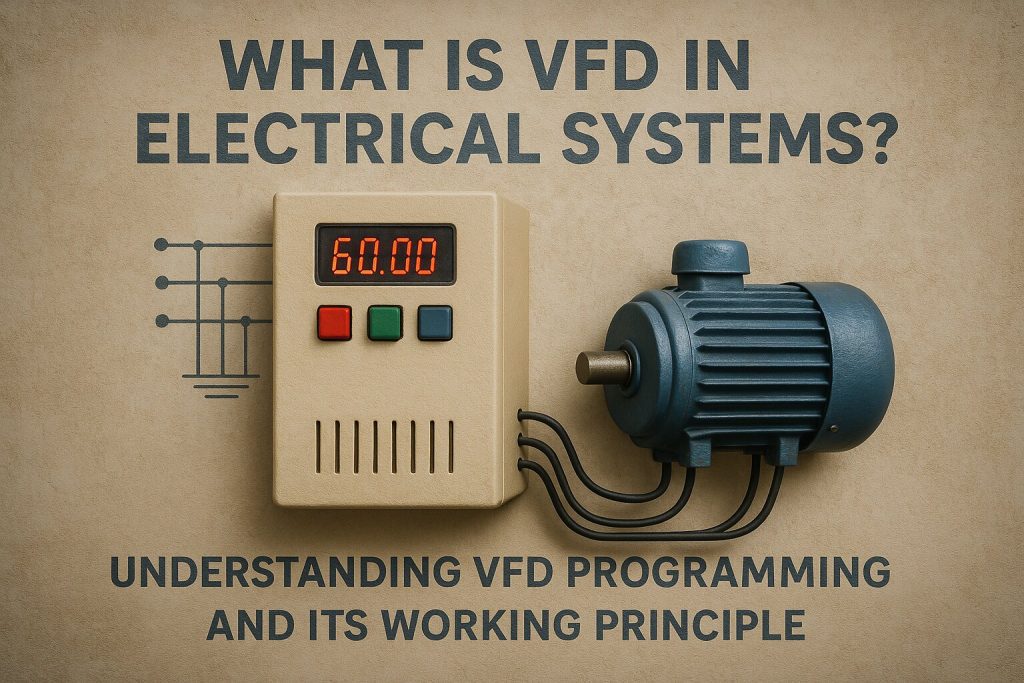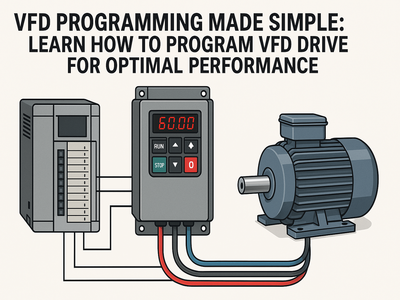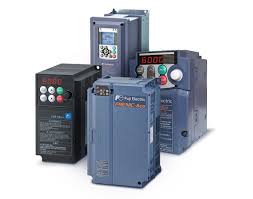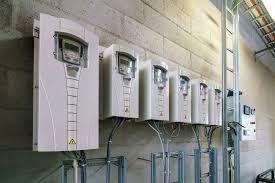Introduction
Variable Frequency Drives (VFD) have become a vital part of every electrical system, permitting accurate control of the speed and the torque of any motor. It can also be how Frequency and voltage supplied to electric motors can be controlled using VFD, which stands for Variable Frequency Drive. It is applicable in industrial automation, HVAC systems, and water treatment plants for energy efficiency and performance optimization. This detailed guide will discuss VFD programming, VFD working principle, VFD programming in PLC, such as Lenze VFD programming, and VFD programming training.
Core Components and Working Principle
The VFD controller controls the input power conversion through the VFD inverter which controls the voltage and frequency supplied to the motor. The VFD working concept is based on pulse-width modulation (PWM) technology that provides accurate speed control and torque control. VFDs are useful for improving motor performance, efficiency, and lifespan and thus it is important to understand their working.
One way to think of a VFD is that it comes in, converts the incoming AC power to DC, and then reconverts it back to AC with a variable voltage and frequency. This provides seamless acceleration and deceleration, which translates into no mechanical wear on the motor.
Types and Functions of VFD Programming
Below are a few different designs of VFDs used to perform unique works:
- Voltage-source inverter (VSI) VFDs: The most common type, known for high efficiency and reliability.
- Current-source inverter (CSI) VFDs: These are Common in high-power applications because of their ruggedness (Fig. 2).
- PWM: PWM VFDs offer high levels of control with low harmonic distortion.
To begin with, the main purpose of a VFD is to regulate motor speed and torque, as well as to enhance energy efficiency and offer overload protection to the motor. The conveyor belts, fans, pumps, and compressors are examples of typical VFD applications. Stable operation and high productivity are achieved when VFD is connected correctly.
Step-by-Step VFD Programming
Basic VFD Programming Acceleration Time Deceleration Time Frequency Limits Your application may have different parameter settings for a VFD compared to another, but these are the basics. Summary: When you are programming VFD drives, you must program them according to the manufacturer’s VFD programming manual to prevent errors and perform smooth operations. If you are working on Lenze VFD programming, you must know how the unique interface and configuration work.
- Most VFD programming procedures involve the following key steps:
- Setting motor specifications in terms of voltage, current, and frequency.
- Define acceleration and deceleration ramps.
- Setting of Torque Limits and Overload Protection.
- It is used to test and improve the performance of the system.
It is always good to have practical VFD programming training to develop practical knowledge and skills.
VFD Integration with PLC Systems
Combining VFD programming in PLC systems allows for advanced automation and real-time control. VFD PLC programming enables seamless communication between the VFD and other control devices, such as sensors and actuators. This integration is particularly beneficial in industrial automation, where precise speed control and data logging are critical.
Key benefits of VFD programming in PLC include:
- Enhanced system flexibility and scalability.
- Improved fault detection and diagnostic capabilities.
- Remote monitoring and control for better efficiency.
Troubleshooting and Maintenance
Proper VFD connection and regular maintenance are essential for preventing common issues such as overheating, electrical noise, and harmonic distortion. Understanding the VFD drive working principle can help identify faults and apply corrective actions promptly.
Common troubleshooting steps include:
- Check input power quality and connections.
- Verifying parameter settings and motor compatibility.
- Inspecting cooling systems and ventilation.
- Analyzing error codes and logs from the VFD programming manual.
Future Trends and Innovations
The future of VFD electrical systems is driven by advancements in IoT and AI. Smart VFD controllers can now perform predictive maintenance, monitor energy consumption in real-time, and adapt to changing load conditions. VFD programming in PLC systems is also evolving with cloud-based platforms and remote access solutions, further enhancing efficiency and reliability.
Conclusion
Mastering VFD programming and understanding the VFD working principle is essential for improving motor performance and energy efficiency. Whether you are working with Lenze VFD programming or other brands, thorough training and adherence to the VFD programming manual are key to success.
Looking to optimize your electrical systems with expert VFD programming solutions? Aknitech offers top-notch VFD programming training, Lenze VFD programming, and VFD PLC programming services. Visit aknitech.in today for more information and expert support!







